| Pages:
1
2 |
teodor
National Hazard
   
Posts: 872
Registered: 28-6-2019
Location: Heerenveen
Member Is Offline
|
|
SbCl3 + Na2S2O3 = something interesting + corrosive fumes of what?
I did a bit more antimony chemistry yesterday.
So, I found this reaction in Ronald Rich "Inorganic Reactions in Water":
2 SbCl3 + 3 Na2S2O3 + 3 H2O = Sb2S3 + 3 Na2SO4 + 6HCl
A day ago I prepared Sb2S3 by bubbling H2S into solution of SbCl3 in hydrochloric acid (see my post about sodium pyroantimonate) but after discovering
this reaction in the book I decided to try this new way.
Now I can say that Ronald Rich is probably wrong becauthe I think the product is not Sb2S3 or not just Sb2S3. I will say something later about that.
Ronald Rich also said that this reaction requires "boiling".
Well, the first thing is not to get side products by mixing SbCl3 solution with thiosulfate. So, I did a small scale experiment first. I mixed 2
volumes of 1M SbCl3 solution in hydrochloric acid and 3 volumes of freshly prepeared 1M thiosulfate solution. For prepearing SbCl3 solution I took
14.6 g ceramic grade Sb2O3 and dissolved it in 30% HCl till all the oxide was dissolved (the volume of solution was around 80 ml at that point). Than
I diluted the solution to 100 ml with water.
So, after mixing the solution was surprisingly clear what is very unusual because when you drop water in SbCl3 solution it always deposits SbOCl, but
when I mixed SbCl3 with thiosulfate the solution was clear. So, there were no sideproducts.
I applied gently heat and the solution turned red (like tomatoes) at some point.
Well, I scaled the experiment and then I used 20 ml of SbCl3 and 30 ml of Na2S2O3. I used a thermometer (see my pictures). At 54 C the reaction
started and the colour was changing with raising of the temperatire. At 85 C it was evident that some low-boiled component is boiling off (small
bubbles at the upper layer of the liquid), also the beaker started to jump (bumping). (But I see the last picture I made was at 65 C so probably it
was really 65C, so I am not sure).
I put the solution to cool and covered it with a watch glass.
After some period of time I found that some yellow compound was sublimed on the watch glass as well as on the sides of the beaker. But real thing had
happened when I tried to vacuum filter the solution. When I poured it I realized some very corrosive fumes started their attack on me. I was in a gas
mask but some of them penetrated. Also I've got a painful burn of my chin just from some invisible fumes. The solution was not hot at this moment
already, so I am puzzled. I know about SbCl3 and SbCl5 but the boiling point of the latest is 140 degrees and I didn't ever expected it is so volatile
in a water solution. So, I am not sure what it was.
Have you any ideas? Is it possible some other corrosive compound of sulfur/chlorine/antimony with boiling point below 85 degrees was also formed?
I am familiar with acidic fumes, I boiled HCl, HBr, H2SO4 but in this case there were no such smell and also no irritation of respiratory tract. Just
the feeling of pepper on your skin and inside your nose. There was no long lasting effect except the chin burn. I suspect it is because it was
moistened in the place of contact with a gas mask and contact of the fumes with a water on my skin made this burn.
Today I finally completed the filtration and the main compound is on the last picture. I think the first cited by me source is incorrect, I found
another reaction in Treadwell:
2 SbCl3 + 3 Na2S2O3 = 4 SO2 + Sb2S2O + 6 NaCl
The colour of the compound suggest it is exactly Sb2S2O, antimony oxysulfide known as a mineral kermesite in nature. I put the picture of Sb2S3 as it
is precipitating by H2S for comparison.
The strange thing is that I didn't noticed any SO2 smell, usually it has ability to stay in a room and accidentally clear you nose from time to time.
Could it react with HCl to form something volatile which I described?
Also I found an old thread about this reaction but don't agree because the different product was mentioned (Sb2S3) and it is also evident that no H2S
was bubbled out from the solution: http://www.sciencemadness.org/talk/viewthread.php?tid=15349
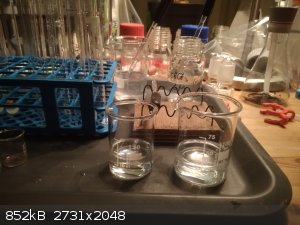 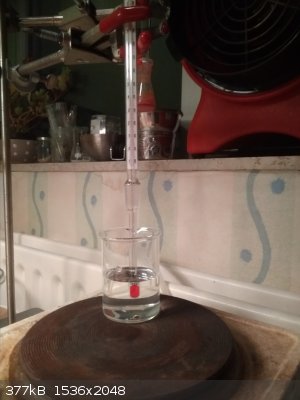 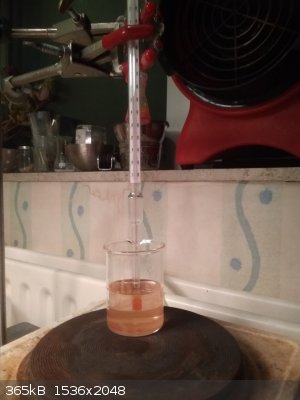 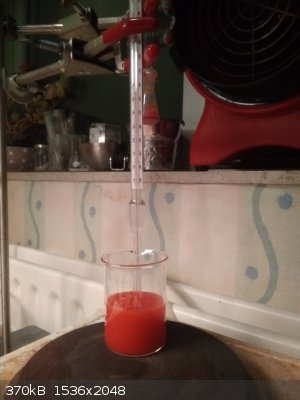 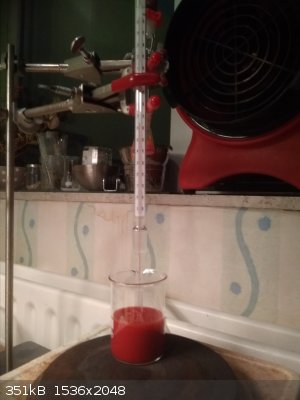 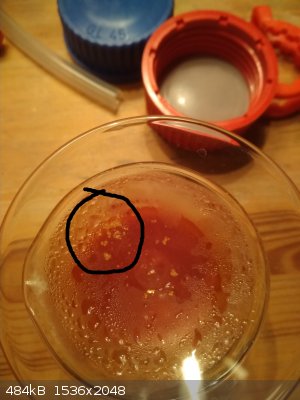 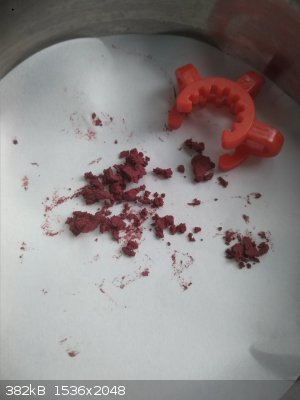
[Edited on 10-9-2019 by teodor]
[Edited on 10-9-2019 by teodor]
[Edited on 10-9-2019 by teodor]
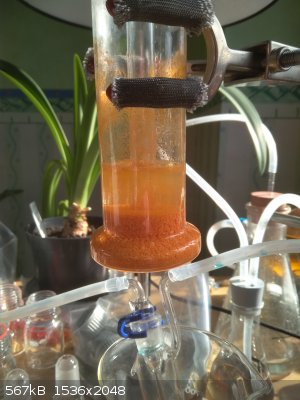
[Edited on 10-9-2019 by teodor]
[Edited on 10-9-2019 by teodor]
|
|
|
fusso
International Hazard
    
Posts: 1922
Registered: 23-6-2017
Location: 4 ∥ universes ahead of you
Member Is Offline
|
|
Where's the Cl?
|
|
|
teodor
National Hazard
   
Posts: 872
Registered: 28-6-2019
Location: Heerenveen
Member Is Offline
|
|
Oh, sorry, it's my miss, I just modified a formula a bit which allowed to type it easily. The original formula from Treadwell & Hall, Analytical
Chemistry, 9th English Edition is
2 Sb+++ + 3 S2O32- = 4 SO2 + Sb2S2O
So, my version of it should be
2 SbCl3 + 3 Na2S2O3 = 4 SO2 + Sb2S2O + 6 NaCl.
Corrected.
[Edited on 10-9-2019 by teodor]
|
|
|
12thealchemist
Hazard to Others
  
Posts: 181
Registered: 1-1-2014
Location: The Isle of Albion
Member Is Offline
Mood: Rare and Earthy
|
|
Antimony sulphide can be hydrated to varying degrees by boiling it in hydrochloric acid. The anhydrous form is black, with the "hydrates" ranging from
yellow through orange to red. Is it possible that this is your red substance?
|
|
|
teodor
National Hazard
   
Posts: 872
Registered: 28-6-2019
Location: Heerenveen
Member Is Offline
|
|
Where I can get the information about "hydrates"? Today I know only 3 really: a "calcined" gray form, a H2S red-orange precipitation like I've got in
the previous experiment and some yellow compound which woelen got by heating the first form in concentrated HCl (https://woelen.homescience.net/science/chem/exps/raw_materia...). and I found different reactions in different sources which suggests that
different Sb2SxOy(Hz) compounds gives different antimony acid anions with NaOH so I try to collect this information in some kind of a system and then
possible try to analyze the compound I've got by converting to antimony acid anions. Also I think that the definition like "hydrate" is not very
precise, I suspect it is some aqua or oxygen complexes. I have no idea how this complexes transforms to each other.
I found it amazing that 2 descriptions of the same reaction which I mentioned (from different books) has slightly different (hydrated) forms of
sulfide as a main product but completely different side products. It suggests that if the side product has the form "either A or B" that difference in
the sulfide (main product) should be also precise and qualitative. So, I think there is a real difference between Sb2S2O and Sb2S3.
According to the fact which compounds of antimony we can find in a nature and their color I think the crimson compound I've got in this experiment is
rather Sb2S2O than Sb2S3 * nH2O but the problem is that Sb2S2O (in nature) can also be a non-stochiometric compound (just by the way how it is
formed), but in my experiment I can expect a stochiometric sample.
Also this term "boiling" which I found also in old literature is not very good, it is better to say "reflux" because we have a case of covalent
compounds (SbCl3, SbCl5) so possible should use some methods and terminology of an organic chemistry 
[Edited on 10-9-2019 by teodor]
|
|
|
teodor
National Hazard
   
Posts: 872
Registered: 28-6-2019
Location: Heerenveen
Member Is Offline
|
|
Actually many questions, possible should read some books. If you can suggest me something I will very appreciate it.
The first strange thing which I don't understand here is why when I mix SbCl3 with water it gives SbOCl2 but with Na2S2O3 solution in water it
doesn't. Starting from this point the questions arise on each step. Like why the boiling point of the mixture is 85 C. So, I will try to RTFM.
[Edited on 11-9-2019 by teodor]
|
|
|
woelen
Super Administrator
        
Posts: 7977
Registered: 20-8-2005
Location: Netherlands
Member Is Online
Mood: interested
|
|
Really interesting what you are doing. I have done quite some experiments with Sb, also by dissolving Sb2O3 in conc. HCl and adding other compounds.
My experience indeed is that compounds of all colors between yellow and orange can be obtained. Particle size may also be part of the puzzle. The red
compound you made is different, however, from what I have seen. Definitely something I will try one of these days.
I also have Sb2O5 (from a Polish seller, Onyxmet). This is a very pale yellow, nearly white, powder. It, however, does not dissolve in conc. HCl.
Probably it is calcined too much. Any suggestions on how to get it in solution as an antimony(V) compound?
|
|
|
j_sum1
Administrator
       
Posts: 6221
Registered: 4-10-2014
Location: Unmoved
Member Is Offline
Mood: Organised
|
|
My Sb knowledge can be written on a postage stamp.
But I wonder that you did not get S precipitating when you added your thiosulfate solution to your very acidic antimony solution.
Or have I misunderstood something?
|
|
|
12thealchemist
Hazard to Others
  
Posts: 181
Registered: 1-1-2014
Location: The Isle of Albion
Member Is Offline
Mood: Rare and Earthy
|
|
Quote: Originally posted by teodor  | | Where I can get the information about "hydrates"? Today I know only 3 really: a "calcined" gray form, a H2S red-orange precipitation like I've got in
the previous experiment and some yellow compound which woelen got by heating the first form in concentrated HCl (https://woelen.homescience.net/science/chem/exps/raw_materia...). . . . . . Also I think that the definition like "hydrate" is not very precise, I
suspect it is some aqua or oxygen complexes. I have no idea how this complexes transforms to each other. |
The information I gave is about the sum total of what I know. It was gleaned from a 1960's book of home chemistry experiments for a (likely teenager)
with a keen enthusiasm for the subject. There is almost no chemical theory, and it just a book of experiments.
|
|
|
teodor
National Hazard
   
Posts: 872
Registered: 28-6-2019
Location: Heerenveen
Member Is Offline
|
|
@j_sum1
No precipitation no gas. It was 2 volumes of ~3.5M HCl (because a half of the concentrated acid reacted with Sb2O3 to form SbCl3) and 3 volumes of 1M
thiosulfate, so ~1.4M HCl in the mixture.
@woelen
Thank you. I will check the particle size and form of crystals also, I believe all I need for that is just a microscope. Also in some sources there is
an information about "antimony cinnabar" Sb2S2O which is really a mixture of Sb2S3 and Sb2O3 but I think it should be possible to check it comparing
chemical properties of Sb2S2O and Sb2S3/Sb2O3 mixture.
I have no experience with Sb2O5 (actually this is my 2nd experiment with antimony). What Treadwell says:
" On strong ignition Sb2O5 loses oxygen and goes over into the very stable Sb2O4 ". Could it be the case with your Sb2O5 sample?
Also "If Sb2O5 is fused with an excess of caustic potash, the product of the fusion probably contains the trimetallic salt of orthoantimonic acid. If
however, the melt is dissolved in a little water and allowed to crystallize, deliquescent crystals of potassium pyroantimonate are formed".
I think that the latest compound is not really "pyroantimonate" K4Sb2O7 but KSb(OH)6 complex { K2H2Sb2O7 * 5H2O = 2KSb(OH)6 } which is used as a
reagent for detecting Na+ ions (NaSb(OH)6 is much much less soluble), so could be detected easily.
Also I would try to heat Sb2O5 with sulfur knowing the fact that molten S can displace O in otherwise inert compounds.
I definitely would delay experiments with heating Sb oxides with Fe (it can reduce Sb to a metal) because of the potentially possible reduction
product - SbH3 which is not less toxic than AsH3.
Well, there is some info from Brauer "Chemically pure Sb can be produced by reduction of Sb2O5 with hydrogen or, more simply, with KCN". Definitely
KCN is a more simple route but I fill a bit uncomfortable with both.
Also, these are really my speculations, but there is some similarity of Tin and Antimony chemistry despite the fact they are in different groups, in
qualitative analysis their separation is the last step, so the compounds go through the same reactions until some point. Based on my experience of
converting calcined SnO2 to a water soluble form I would try heating the antimony oxide with Na2CO3 and S (if only S is not enough) trying to get
water soluble sodium thioantimonates.
Also, I would try concentrated HBr but of course with little chances. But I found the information somewhere than chemically otherwise inert SnO2 goes
into solution when it is refluxed with HI. And HBr is something in the middle.
[Edited on 11-9-2019 by teodor]
|
|
|
teodor
National Hazard
   
Posts: 872
Registered: 28-6-2019
Location: Heerenveen
Member Is Offline
|
|
I am thinking about what j_sum1 noticed. Yes, really I was more surprised about absence of SbOCl precipitate than about absence of S. So, just to
check what can be wrong with my thiosulfate I did a small experiment, here is the picture. Equal volumes of the thiosulfate solution used in the first
experiment and 2M HCl was mixed, but in the second tube 3 drops of my SbCl3 solution was added initially. It looks like SbCl3 really works as
inhibitor of the expected reaction between HCl and Na2S2O3. Obviously, addition SbCl3 _after_ the reaction doesn't change anything.
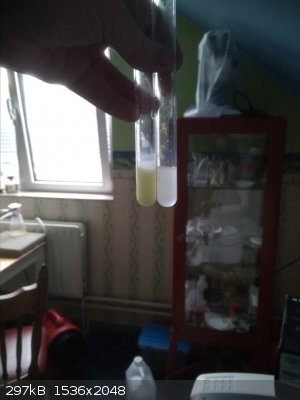
[Edited on 11-9-2019 by teodor]
|
|
|
woelen
Super Administrator
        
Posts: 7977
Registered: 20-8-2005
Location: Netherlands
Member Is Online
Mood: interested
|
|
You do a lot of interesting observations. That is something which I like in your work in general. The inhibition of decomposition of thiosulfate also
is quite interesting.
I looked up one of my books on the chemistry of the elements. It is a somewhat older book, from the 1950's (Lehrbuch der anorganische Chemie, part I,
by H. Remy). I made a picture of the section on antimony trisulfide and it also mentions the red color you get on addition of thiosulfate. Attached to
this post is the section of that book.
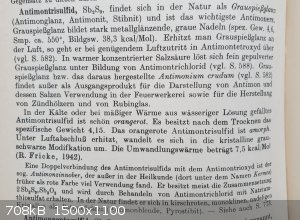
|
|
|
teodor
National Hazard
   
Posts: 872
Registered: 28-6-2019
Location: Heerenveen
Member Is Offline
|
|
Thanks woelen, indeed it's very pleasant when somebody notices your work but to get real satisfaction from it I need to explain at least some results,
just for myself, and it will be great to do it with your help.
Sorry, I don't read Germany, it is my shame also because a lot of interesting works exist without translation.
Yes, I think everything we are discovering now about inorganic compounds exists in some old and forgotten books already. My great discovery was
information I found in the old work of John Herschell which he wrotes about thiosulfates. I did some experiments with barium thiosulfate where I
observed some quirks of the ion, and it was Herschell who described it first. I put my own observations in this thread: http://www.sciencemadness.org/talk/viewthread.php?tid=152049
And I mention this thread now because I try to use the same method now to check the presence of the thiosulfate ion after mixing SbCl3 and Na2S2O3.
Here is the picture which shows that after mixing the ion possible is not present.
The tubes:
1) Mix of SbCl3 and Na2S2O3, cold reaction, after 5 hours.
2) Mix of SbCl3, Na2S2O3 and BaCl2, mixed several minutes ago.
3) Mix of Na2S2O3 and BaCl2 and H2O (to get the same concentration), mixed few minutes after mixing solution in tube 2.
Yes, you probably noticed, the second tube contains also HCl to keep SbCl3 in the solution, so it is not clear whether HCl or SbCl3 prevents the
precipitation of BaS2O3. I made 4th tube with the same concentration of HCl, Na2S2O3 and BaCl2, it is hard to make a picture because of sulfur
cloudiness, but there is a small precipitation like BaS2O3 in this tube.
So, it is possible that SbCl3 immediately after mixing bounds S2O32- in some form of complex which prevents its precipitation as BaS2O3 as
well as reacting with HCl. But precipitation of Sb2S2O/Sb2S3 is another kind of process and it goes but when the solution is cold it goes slowly.
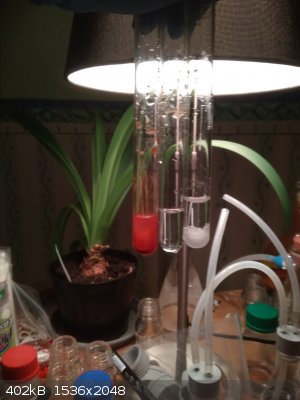
UPD. I am still not sure how to make this experiment accurately, BaS2O3 precipitation is one of the most weird among such kind of reactions: it has
backward dependence both on temperature and concentration: both higher temperature and more concentrated solution slows the reaction until some point
(and at highest concentration it goes immediately). So, probably will check everything again.
[Edited on 11-9-2019 by teodor]
[Edited on 11-9-2019 by teodor]
[Edited on 11-9-2019 by teodor]
[Edited on 11-9-2019 by teodor]
|
|
|
teodor
National Hazard
   
Posts: 872
Registered: 28-6-2019
Location: Heerenveen
Member Is Offline
|
|
Also I found descriptions of some variations of the reaction (which gives Sb2S3 but not Sb2S2O). Here -
https://books.google.nl/books?id=i9swy1D2HxIC&pg=PA241&a...
"
Desai et al. (1995) used this chemical method to prepare films Sb2S3 from the aqueous solution of SbCl3 * 9 H2O
(Sb source), tartaric acid (complexing agent)
and thioacetamide (S source), with a pH ~ 1–2. Glass substrates were vertically dipped in
the solution for 6 h. After heat-treatment at 200° C, polycrystalline films could be obtained.
Grovzdanov et al. (1994) prepared amorphous Sb2S3
films on glass and polymer substrates, using this method. They let solid SbCl3
(~4.0 g) dissolve in glacial acetic acid (~8 ml) and then added, dropwise, a 1.0 M aqueous solution of Na2S2O3
(~100 ml) to it, under stirring. A clear solution was obtained. The pH of the solution should be
~3 and it could be adjusted with diluted acetic acid, if necessary. The temperature of the
solution must be less than 20°C and cold water was used. A complex compound, antimony
thiosulfate, then gradually formed, corresponding to the color of the solution changing
from colorless to yellow, or orange. Glass slides were dipped in the solution for at least 5 h,
in order to ensure good adherence of the films. The as-deposited films were amorphous,
uniform and transparent and bright yellowish to orange in appearance.
"
Also in the table Na2S2O3 is mentioned both as complexing agent and S source. And the resulting compounds as c-Sb2S3 in a case of tartaric acid
complex and a-Sb2S3 in a case of the thiosulfate complex.
[Edited on 11-9-2019 by teodor]
UPD even more information about this complex there is in the cited work ( Grovzdanov, 1994). I've attached the pdf. There is a detailed description
how Sb2S3 is formed.
[Edited on 11-9-2019 by teodor]
Attachment: grozdanov1994.pdf (468kB)
This file has been downloaded 281 times
[Edited on 11-9-2019 by teodor]
|
|
|
Bedlasky
International Hazard
    
Posts: 1219
Registered: 15-4-2019
Location: Period 5, group 6
Member Is Offline
Mood: Volatile
|
|
Teodor: Where you get Sb2O3?
|
|
|
Fery
National Hazard
   
Posts: 990
Registered: 27-8-2019
Location: Czechoslovakia
Member Is Offline
|
|
here some info about the reaction when using thiosulphate+hydroxide, but you used acidic environment... just copying, did not try it in any experiment
SbCl3 + 3Na2S2O3 = Na3Sb(S2O3)3 + 3NaCl
2Na3Sb(S2O3)3 = Sb2S3 + 3Na2S3O6
"When using Na2S2O3 with NaOH, the color of product is influenced by the proportion of hydroxide (from red to yellower when increasing hydroxide),
... the product is contamined with oxide."
Bedlasky - in our country you can buy Sb2S3 tech. grade from a shop selling pyro compounds at price 320 CZK (12 EUR) per 1 kg and convert it... I know also another shop with the same price in Brno.
|
|
|
woelen
Super Administrator
        
Posts: 7977
Registered: 20-8-2005
Location: Netherlands
Member Is Online
Mood: interested
|
|
Sb2O3 can be purchased at ceramics/pottery shops. Sb2S3 I obtained from eBay. Both chemicals are cheap and can be obtained in good purity (better than
99%).
|
|
|
teodor
National Hazard
   
Posts: 872
Registered: 28-6-2019
Location: Heerenveen
Member Is Offline
|
|
@Bedlasky
Keramikos
@Fery
Yes, I unable to work in alkaline environment without getting SbCl3 in solid form which probably I will try but didn't figure out how to make its
distillation yet. Taking in consideration higher boiling temperature of SbCl3 than SbCl5 I will probably try to get SbCl5 first. Both compounds are
very corrosive so I should make a detailed plan first.
The reaction mechanism between Na2S2O3 and SbCl3 is really very interesting and probably can give different side products and different forms of the
sulfide/oxysulfide. See the work of Grozdanov which I attached for the details.
When the reaction (in acidic environment) goes in cold the byproduct is SO2 (detected by smell) and the product is red. When in hot the product has a
crimson colour and I suspect formation of some lachrimator. I plan the experiment to trap byproducts but it is more complicated than SbCl5
distillation, so put in queue.
|
|
|
Simoski
Hazard to Self
 
Posts: 82
Registered: 24-12-2017
Location: Johannesburg South Africa
Member Is Offline
Mood: No Mood
|
|
Is Antimony Oxide a common pottery/ceramics chemical?
|
|
|
Simoski
Hazard to Self
 
Posts: 82
Registered: 24-12-2017
Location: Johannesburg South Africa
Member Is Offline
Mood: No Mood
|
|
Quote: Originally posted by woelen  | | Sb2O3 can be purchased at ceramics/pottery shops. Sb2S3 I obtained from eBay. Both chemicals are cheap and can be obtained in good purity (better than
99%). |
Ta sport, first thing I would try if I could get or make some Sb2S3, mix with equal weight potassium chlorate and strike with a hammer, impact
detonation tests.
What would the combustion products of that detonation be... The the chloride salt of Antimony and sulfur dioxide?
[Edited on 12-9-2019 by Simoski]
|
|
|
teodor
National Hazard
   
Posts: 872
Registered: 28-6-2019
Location: Heerenveen
Member Is Offline
|
|
Fery, I realize that theoretically it could be possible to do this reaction in alkaline environment, starting fromSbCl3 solution in HCl and then make
it alkaline by neutralizing HCl. Because, as we know already
2 S2O32- + Sb3+ = [Sb(S2O3)2]-
so, after formation of this complex we don't need HCl. Theoretically.
Practically I think we still need HCl for the complex stability, I should check this.
Also the site atomistry.com doesn't give any references. Neither Grovzdanov.
But according to Grovzdanov the complex is NaSb(S2O3)2 and not Na3Sb(S2O3)3 and it looks logically (the latest one looks like just the complex +
thiosulfate molecule), so there is at least one error in the information they provide on the site. Also, according to my reference, the thiosulfate
gives S in acidic media and how it gives it in alkaline is something which should be explained.
Does anybody know where we can get more information about [Sb(S2O3)2]- complex?
[Edited on 12-9-2019 by teodor]
|
|
|
teodor
National Hazard
   
Posts: 872
Registered: 28-6-2019
Location: Heerenveen
Member Is Offline
|
|
@woelen: It seams that the translate application in my Android was much improved from the moment I tried to use it last time. So I was able to
translate the page you posted.
I figured out with some additional experiments that 2 Sb2S3 * Sb2O3 is the result of the reaction of thiosulfate with SbCl3 in acidic environment and
Sb2S3 in such environment which is in process of changing its pH to alkaline. So, @Fery, you were right, The colours of Sb2S2O and Sb2S3 in solutions
are cherry-red and orange, the latest changes it to red-orange upon standing but they are still quite different. For each compound it seams that it
always the same not depending on reagent concentrations, can be altered only by additional Sb2O3 deposit.
The chemically the first (which I write as Sb2S2O for simplicity) is more inert, it dissolves in NaOH very slowly forming cloudy solution. Sb2S3
dissolves very fast forming a clear solution.
Also I was unable to get a stable thiosulfate complex in alkaline environment. When I try to add KOH to SbCl3 + HCl + Na2S2O3 mix it gives Sb2S3
deposit almost immediately even before the solution becomes neutral.
Dissolving Sb2O3 in NaOH is a quite tough task and requires a special procedure, I will write later on it. It seams that addition of Na2S2O3 doesn't
help much (so complex is not forming or not stable) but its addition to a hot solution turns its colour, the solution becomes gray.
[Edited on 14-9-2019 by teodor]
|
|
|
woelen
Super Administrator
        
Posts: 7977
Registered: 20-8-2005
Location: Netherlands
Member Is Online
Mood: interested
|
|
I have done experiments with this as well. I found that the formation of the red compound only occurs at concentrations close to 1M. In concentrated
solutions it is not formed at all.
I dissolved a fairly big spatula full of Sb2O3 in 37% HCl. In another test tube I made a concentrated solution of Na2S2O3 in distilled water. On
mixing the solutions, nothing seems to happen, but after a while (much slower than without Sb2O3) the liquid turns cloudy, pale yellow: the well-known
color of decomposing thiosulfate in acidic solution.
I repeated the experiment in the cold, in hot water, and also in cold water, which I slowly heated. Under these conditions, I never obtained the red
compound when a high concentration of Sb2O3 and Na2S2O3 is used. I also played with relative amounts of Sb2O3 and Na2S2O3.
It is interesting to see that the higher concentration does not lead to formation of the red compound. I suspect that it has to do with the much
higher concentration of HCl, which is needed to get (and keep) much Sb2O3 in solution. Getting solutions, high in Sb-content, but with just 1M or 2M
of acid, is not possible, due to formation of SbOCl. The strongly acidic solution may prevent formation of Sb2S3 and/or Sb2S2O.
|
|
|
teodor
National Hazard
   
Posts: 872
Registered: 28-6-2019
Location: Heerenveen
Member Is Offline
|
|
Interesting results, woelen.
By the way, inability to precipitate Sb2S3 from too acidic solution is well known fact in analytical chemistry. The same is with H2S. To get Sb2S3
without SbOCl the concentrated solution should be saturated with H2S , than diluted (dissolved H2S prevents SbOCl formation) and only after that it is
possible to precipitate sulfide with additional H2S. The reason is that Sb2S3 dissolves in concentrated HCl, so doesn't precipitate.
I have still some ideas to try. By the way, tartaric acid complex can possible help to get the solution concentrated in Sb. But I am also curious how
Sb (V) would react (it doesn't require HCl to keep it in solution).
[Edited on 15-9-2019 by teodor]
|
|
|
nuciferanelumbo
Harmless

Posts: 1
Registered: 17-9-2019
Member Is Offline
|
|
Quote: Originally posted by teodor  | @woelen: It seams that the translate application in my Android was much improved from the moment I tried to use it last time. So I was able to
translate the page you posted.
I figured out with some additional experiments that 2 Sb2S3 * Sb2O3 is the result of the reaction of thiosulfate with SbCl3 in acidic environment and
Sb2S3 in such environment which is in process of changing its pH to alkaline. So, @Fery, you were right, The colours of Sb2S2O and Sb2S3 in solutions
are cherry-red and orange, the latest changes it to red-orange upon standing but they are still quite different. For each compound it seams that it
always the same not depending on reagent concentrations, can be altered only by additional Sb2O3 deposit.
The chemically the first (which I write as Sb2S2O for simplicity) is more inert, it dissolves in NaOH very slowly forming cloudy solution. Sb2S3
dissolves very fast forming a clear solution.
Also I was unable to get a stable thiosulfate complex in alkaline environment. When I try to add KOH to SbCl3 + HCl + Na2S2O3 mix it gives Sb2S3
deposit almost immediately even before the solution becomes neutral.
Dissolving Sb2O3 in NaOH is a quite tough task and requires a special procedure, I will write later on it. It seams that addition of Na2S2O3 doesn't
help much (so complex is not forming or not stable) but its addition to a hot solution turns its colour, the solution becomes gray.
[Edited on 14-9-2019 by teodor] |
I am not sure if you are aware that Sb2S3 in amorphous phase is orange, but if heated at 250oC it will turn into crystalline Sb2S3, which has a dark
gray color.
|
|
|
| Pages:
1
2 |